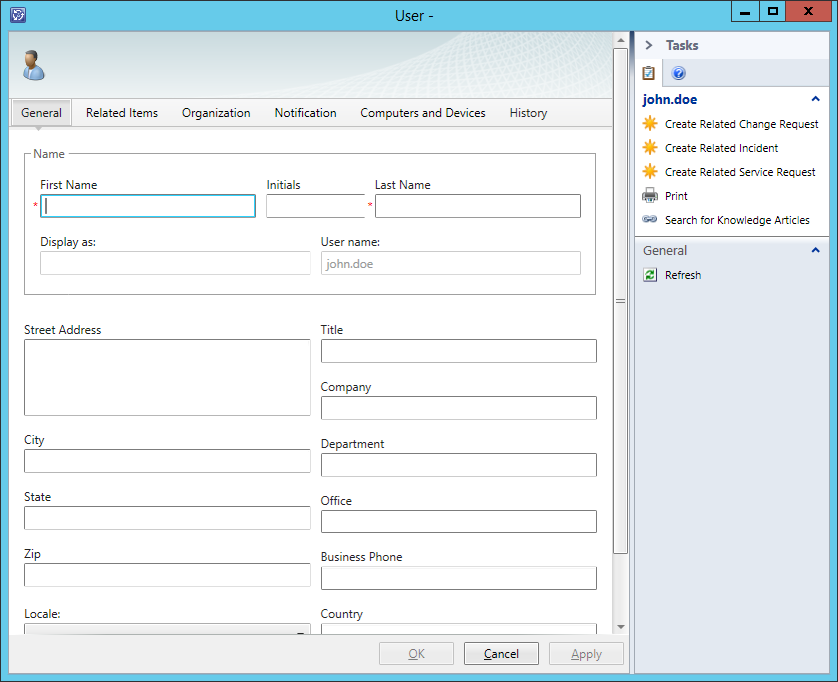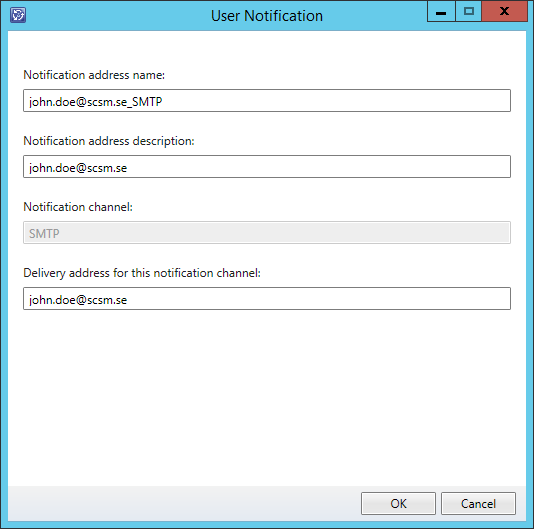Here’s another useful PowerShell snippet which I created when I built my PowerShell Exchange Connector for SCSM. The function itself will return the user object of the given e-mail address. If no user is found you also have to option to create the user object using the -CreateUser switch.
The function have the following parameters:
-EmailAddress
The e-mail address of the user who you want to retrieve
-CreateUser
If this switch is enetered, the function will create a user object if no match is found in the CMDB
-Name
If you know the name of the user that you might create, you can specify the name of the object in this parameter
The script itself:
# This function will return the user object of the specified Email Address. If a matching user isn't found, the function can create an Internal user within the SCSM CMDB
# NOTE: SMlets must be loaded in order for the function to work
Function Get-UserByEmail {
param (
[parameter(Mandatory=$True,Position=0)]$EmailAddress,
[parameter(Mandatory=$False,Position=1)][switch]$CreateUser,
[parameter(Mandatory=$False,Position=2)]$Name
)
# Get all the classes and relationships
$UserPreferenceClass = Get-SCSMClass System.UserPreference$
$UserPrefRel = Get-SCSMRelationshipClass System.UserHasPreference$
$ADUser = Get-SCSMClass Microsoft.Ad.User$
# Check if the user exist
$SMTPObj = Get-SCSMObject -Class $UserPreferenceClass -Filter "DisplayName -like '*SMTP'" | ?{$_.TargetAddress -eq $EmailAddress}
If ($SMTPObj) {
# A matching user exist, return the object
# If, for some reason, several users are found, return the first one
If ($SMTPObj.Count -gt 1) {$SMTPObj = $SMTPObj[0]}
$RelObj = Get-SCSMRelationshipObject -TargetRelationship $UserPrefRel -TargetObject $SMTPObj
Return $AffectedUser = Get-scsmobject -Id ($RelObj.SourceObject).Get_Id()
} elseif ($CreateUser -and !$SMTPObj) {
# A matching user does NOT exist. Do some processing to get the needed properties for creating the user object
If (!$Name -or $Name -eq '') {
$Name = $EmailAddress.Substring(0,$EmailAddress.IndexOf("@"))
$UserName = $Name.Replace(",","")
$UserName = $UserName.Replace(" ","")
} else {
$Name = $Name
$UserName = $Name.Replace(",","")
$UserName = $UserName.Replace(" ","")
}
# Try Username to make sure we have a unique username
$Loop = $TRUE
$i = 1
While ($Loop -eq $TRUE) {
$tempUser = Get-SCSMObject -Class (Get-SCSMClass System.Domain.User$) -Filter "UserName -eq $UserName"
If ($tempUser) {
$UserName = $UserName + $i
$i = $i +1
} elseif ($i -gt 15) {
Throw "Unable to find a unique username for the new user"
} else {
$Loop = $False
}
}
# Create the Property Hash for the new user object
$PropertyHash = @{"DisplayName" = $Name;
"Domain" = "SMINTERNAL";
"UserName" = $UserName;
}
# Create the actual user object
$AffectedUser = New-SCSMObject -Class (Get-SCSMClass System.Domain.User$) -PropertyHashtable $PropertyHash -PassThru
# Add the SMTP notification address to the created user object
If ($AffectedUser) {
$NewGUID = ([guid]::NewGuid()).ToString()
$DisplayName = $EmailAddress + "_SMTP"
$Projection = @{__CLASS = "System.Domain.User";
__SEED = $AffectedUser;
Notification = @{__CLASS = "System.Notification.Endpoint";
__OBJECT = @{Id = $NewGUID;
DisplayName = $DisplayName;
ChannelName = "SMTP";
TargetAddress = $EmailAddress;
Description = $EmailAddress;
}
}
}
New-SCSMObjectProjection -Type "System.User.Preferences.Projection" -Projection $Projection
}
# Return the created user object
Return $AffectedUser
}
}
Using the function to retrieve a user:
Using the -CreateUser switch:
You can also download the whole script as a file here: Get-UserByEmail





